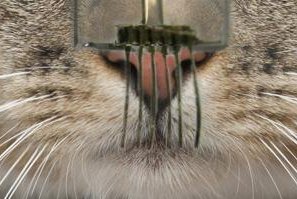E-whiskers, pictured above, developed by researchers at the University of California at Berkley, are highly responsive tactile sensor networks made from carbon nanotubes and silver nanoparticles that resemble the whiskers of cats and other mammals. (Credit:University of California at Berkley)
When you think of a robot the last thing you would imagine is one with cat-like whiskers, but nanotechnology researchers have developed tactile sensors that resemble cat whiskers to help robots perceive their surroundings.
The whiskers are made from carbon nanotubes, providing a structural matrix, and silver nano particles that are highly sensitive to any mechanical stress. They can sense one joule of pressure, equivalent to the pressure of a dollar bill placed on a desk.
“The strain sensitivity and electrical resistivity of our composite film is readily tuned by changing the composition ratio of the carbon nanotubes and the silver nanoparticles,” said lead researcher Ali Javey of the University of California at Berkley.
Javey and his team have also worked on e-skin and other electronic devices to help sense surroundings. During this research, published in the journal Proceedings of the National Academy of Sciences, they found that by using the elastic fibers with a small spring constant, they could record even the smallest of applied pressures.
They were able to demonstrate this by using the whiskers to successfully map a 2D and 3D model of wind flow. They said that this kind of technology could be used on wearables as well, to sense heart and pulse rates.
“The ease of fabrication, light weight and excellent performance of our e-whiskers should have a wide range of applications for advanced robotics, human-machine user interfaces, and biological applications,” Javey said.
[University of Berkley]
[PNAS]















